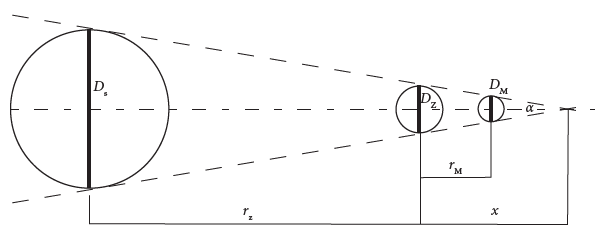Practical Exercise 3: TYPES OF LUNAR ECLIPSES – DIFFERENCES FROM SOLAR ECLIPSES
When viewed from Earth, the disk of the Sun is approximately the same size as the disk of the Moon. Therefore, a total, annular and hybrid solar eclipse may occur. When the Moon is eclipsed, the situation is completely different. The shadow cast by the Earth into space is so great that the Moon will always fit in whole. A lunar eclipse is always observable from the entire Earth's hemisphere, where there is night.
The Moon also does not orbit the Earth in the same plane as the Earth around the Sun (= in the ecliptic plane). Therefore, a lunar eclipse will occur only if all three bodies exceptionally reach the same plane. If they orbited in the same plane constantly, the Moon would be eclipsed with each full moon.
a) Under what conditions could an annular lunar eclipse occur? If possible, try to refine these conditions by calculation.
b) Why sometimes a complete and sometimes only a partial lunar eclipse occurs?
Objective of Practical Exercise
The aim of this activity is to explain to pupils the fundamental difference between a solar eclipse and a lunar eclipse. When a solar eclipse can occur, a total, annular or hybrid eclipse can occur because the angular magnitudes of the Sun and Moon in the sky are comparable. When the lunar eclipse occurs, there is always a total eclipse, because the moon always fits into the cone of shadow cast by the Earth. The pupils will further clarify the effect of the inclination of the plane of the Moon's orbit around the Earth relative to the ecliptic plane on the type of lunar eclipse.
Methodical notes for the teacher
• At first glance, it is clear that for the possible occurrence of an annular lunar eclipse, the change in distances or sizes of the bodies involved would have to be huge, and it is therefore unrealistic to observe an annular lunar eclipse. Nevertheless, it is especially useful with gifted students to calculate the parameters of such a situation. An enlargement of the Moon or its approach to Earth are possible options. Both results are more or less from the field of “physical or astronomical humour”.
Sample answer:
a) An annular eclipse of the Moon could occur only if the shadow cast by the Earth was smaller than the size of the Moon at the point of its intersection with the trajectory of the Moon. In that case, the Moon would have to be much larger. The second possibility is that it would be several times further away than now. Neither of these options is very realistic. Nevertheless, it is possible to perform specific calculations, see the figure.

The Earth casts a conical shadow with a vertex angle into space
First, we calculate the distance of the apex of the cone from the Earth x from the equation
.
First, we look for the cut-off diameter that the Moon would have to have at the current distance for an annular lunar eclipse to occur. It would have to be true that
i. e. the Moon would have to be almost 3 times larger than it actually was.
We are now looking at what limit distance the Moon would have to be at its current size for an annular lunar eclipse to occur. This must again be true , now we express
and, and
,
i. e. the Moon would have to be more than 2.6 times its actual distance away.
b) If the Moon is near the ecliptic plane at the moment of the lunar eclipse, it will fit entirely into the cone of shadow cast by the Earth. If it is further from the ecliptic plane, there may be a situation where only a part of the Moon enters the shadow of the Earth. However, this does not mean that the shadow cast by the Earth is smaller. The Moon just “doesn't fit in exactly”.


